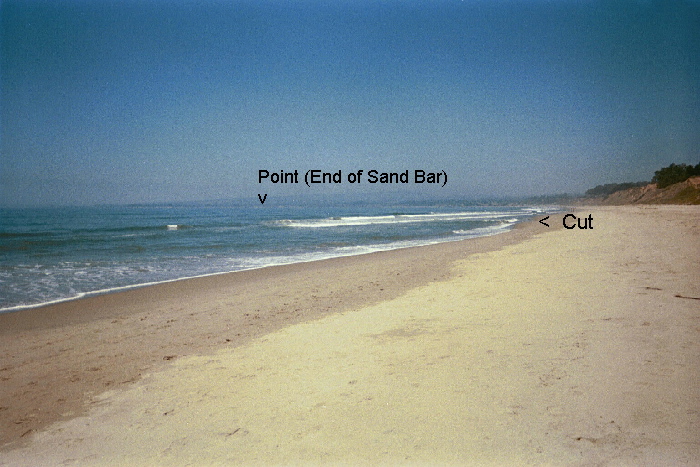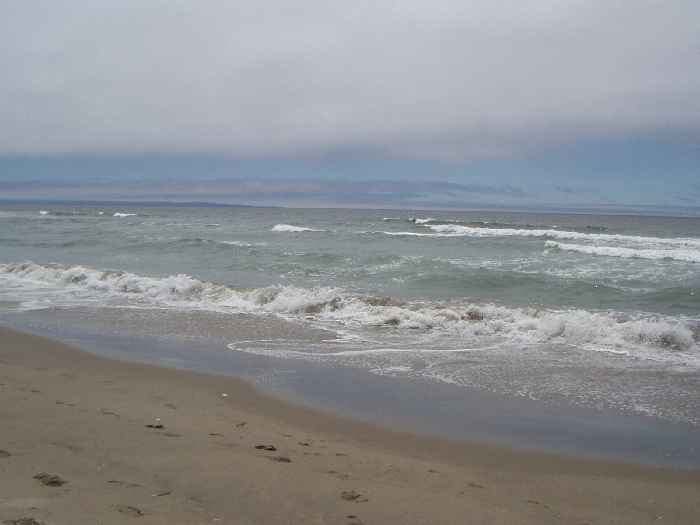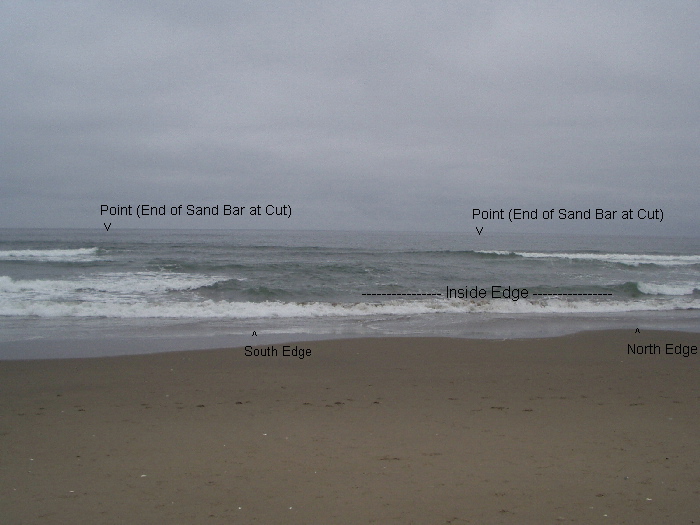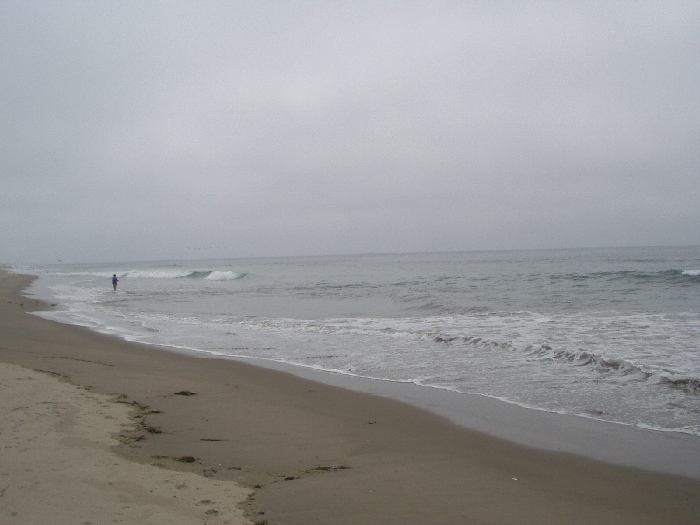Moving water is the most important indication! The idea of looking for moving water in the surf may sound ridiculous because the surf is always in motion, but we are looking for a special kind of moving water. This moving water is like a river flowing without shores within the surf zone. In general, this moving water should:
- persist over time (long enough for fish to find and exploit)
- cause movement of food over holding water
- have a good path back to deeper water
The persistence of water movement occurs over many different time frames. It could form only once for a few hours so that fish happen on it during that time start to collect there. It can also persist for weeks or months and become historic feeding areas (example shown in the first cut discussed below). In this case, the fish runs are historic and large and might in fact happen under the same conditions every year.
If good feeding conditions exist over broad areas then it will be difficult to find large concentrations of fish. If good conditions are rare but exist in a few areas then these areas are likely to support large concentrations of fish. So conditions can be too good over a broad area or not good anywhere. Under these conditions you will have to be content with finding a few stragglers. The way to think effectively about finding fish is to maintain a broad view and narrowing your view to the high probability locations that hold large concentrations of fish. Finding moving water by using all the indications available to you is key.
It should be obvious why movement of food is important. Having a good path back to deeper water is key because it will provide a good entry and exit path for fish that are feeding in that area, provide good current and might also provide a natural chum trail for fish to follow. Many times we have found a nice structure that was too shallow over the sand bar and because of lack of easy access for fish those places may not have a large concentration of fish. At times, these areas (even if they appear to be very shallow) can have large concentrations of fish.
This discussion is based on our experiences fishing the sandy beaches that exist between Seascape and Sunset State Beach. These beaches have fine sand, slight to moderate slope and have both soft and hard sand bottoms. We have fished occasionally North of Santa Cruz and we can find fish using these methods. The beaches have large swells in general and are a steeper, but give similar indications of moving water. More rocky areas exist so these areas will involve swell interactions with rock and kelp structures. We haven't had much experience in that but still manage to find fish with our methods. We fished Half Moon Bay beaches (especially Francis Beach at the end of Kelly) several times last year and a few times this year. Beaches there have are steeper and have coarser sand. In July and August, we have found much larger swell conditions and huge structures formed. One example, is a trough at the inside edge over much of the beach that was 1 to 3 feet deep just beyond the water beach of the last breaker. One step too far here and you will be swept into heavy water by the large backwash forces there. Using the ideas presented here, you can find fish there as well.
Look at this photo of a nice cut. It is a small cut found near low tide with low current flow. The beach slope is mild. The bottom is soft sand that is rich with sand crabs. The area just North of the cut is a soft-sand flat over which water is washing to form the cut. Enough water moves over the flats to create the cut angled back to deeper water.

Cut refers to the trough that is cut through the sandy bottom. Water movement back to deeper water cause the cut. The water pressure is a result of the combined action of waves formed by swells. The water that is pushed up on the beach finds a path down the sandy slope. This action typically occurs over the soft sandy bottoms that hold sand crabs and other burrowing forage so it results in ideal conditions to find fish.
Similar processes may form a hole but holes are wider with less current and moving water.
Cuts and holes are almost always found adjacent to high spots on the beach that form points protruding into the surf zone.
This particular cut had high fish concentrations at low tide and a few hours into flood over a period of weeks. It provided many of the best close-in, persistent big school and big fish bites I have ever experienced for fish up for 1 to 2 pounds. Schools of fish can hold in the flats just north of the cut. Typically, the sweet spot is right on the current seam. Casts onto the flats (North of the cut) get washed into the cut. Fish can hold anywhere in this area. They can also be found on the inside edge (adjacent to the shoreline and all edges of turbulence around the cut but these are lower probability spots.
Another sweet spot is the area where the cut penetrates the sand bar (near the area that the swells stop breaking). If other fishermen occupy sweet spots, then you can also work the shoreline south of the start of the cut and cast straight out beyond the outside edge and retrieve allowing the fly to drift left and over the edge. You can walk South incrementally to cover the entire area including an area of turbulent water of the last breaker (the inside edge). Sometimes, the fish are so close that I'm almost stepping on them. Be sure to spot-check the inside edge. This is usually lower probability but I have found schools in close especially in areas that retain some depth even with successive wave action; for example, where there is a shoreline trough or where opposing waves keep water pushed into a pocket. These areas usually look clearer with a nervous surface.
Here is a similar structure at Sunset State Beach in July 2002 but on a grand scale compared to the first cut. The trough extended for hundreds of feet to the south and the width extended to much deeper water. Its current flow and the hydraulic pressures involved were an order-of-magnitude greater. By this time of the year, beaches towards Santa Cruz had flattened out and visible structure was not apparent most of the time.

This water is fished the same way as the smaller scale water but line control is harder to achieve with heavier surf because of the hydraulics, and you cannot cover the extent of the structure because much of it is out of reach (beyond 80 feet). You can still cover most of the water using light conventional gear (with casts to 150 feet). Again, fish the moving water.
Here is a smaller structure that appeared at Sunset in August 2002. It is a much smaller scale structure having a North edge and a South edge within the picture. The large structures are no longer typical. The swells are smaller and the dimensions of the cut are much smaller.

This water is fished in the same way. The flats on either side of the deep water frequently hold schools of larger fish but by far the most productive places to fish are the sweet spots near the north and south edges and sand bar points at the current seam. The inside edge frequently hold fish that work along it but it is lower probability. The flats have foamy water but you can often see signs of water movement over them. Casts over or along these water movement areas are more likely to produce fish. If there is another cut or hole that is adjacent then there are frequent wave interactions to produce water movement that can hold fish.
Study the foamy flat areas (adjacent to cuts) for visual indications (water surface disturbances, turbulence indicating water movement, sand clouds and dispersion path, foam flow and dispersion, color/clarity...) and tactile indications (sandy bottom characteristic, direction and speed of line drifting, load changes felt in retrieving line...). Often in areas that hold a lot of fish, the bottom you are wading over has very soft sand (that feels spongy) with lumps (sand crabs that you can feel through the bottoms of your surf booties).
With persisting small swell conditions, all beaches get flat and the features become less distinct. Here is a structure at Sunset that appeared in Mid-August after a couple weeks of low swell condition.

Again, this water is fished in the same way but larger fish are more likely to be found in the foamy water adjacent to the deeper water. This flat state makes it less likely that you will find big concentrations of fish. More fish will be dispersed or out of reach. You can see Jim in this picture working the far edge - one of the higher probability places to find fish here.
Moving water can be found at any moon phase/tide condition in any swell/weather condition. April through August 2002, we have found moving water (holding fish) independent of tide and weather. We still have little experience September through March because our attention shifts to in-land Stripers (SF Bay, Frank's Tract and San Luis Reservoir/O'Neil Forebay).
We have seen conditions at Sunset that looked to have too much moving water at typically fish-holding seams. The hydraulics makes line control almost impossible. If you can control the drift and get down to fish then you can catch them in these areas but typically line sweeps over these areas so fast that it is not able to get to depth. For tips on how to deal with this condition, see the article on line control.
It is less likely to find moving water at high and low tide, with smaller swell conditions, and on the flat beaches caused by small swell conditions over long periods. We have found fish-holding moving water under all of these conditions and do not let tides or weather conditions keep us from fishing.
Beach structure can change within a day's fishing on soft sand beaches. Cuts move and change shape. They disappear. They may still exist and provide wonderful fish-holding areas but appear to be gone. Small cuts and troughs can form and disappear in hours as the tide changes. Good fishing areas change with the tide and the fish shift on the beach to better feeding areas so to stay in fish you have to move.
We see many variations of the scale and configuration of cuts with moving water. On our local SF Peninsula beaches, the dynamics of sand movement are dependent on:
- Number of swell sources (typically, Northwest and Southwest for Santa Cruz, California area beaches)
- Swell size
- Swell direction
- Beach slope and compass-orientation to swell sources
- Beach and coastline topology
- Bottom characteristics (soft / hard)
Most of the beaches North of Santa Cruz face West and are affected by both Northwest and Southwest swells. Some of the beaches like 4-mile beach are in a cove that gets sheltered from NW swells but the surf is typically bigger at Scott Creek, Waddell Creek, Bean Hollow, Pescadero and San Gregorio. Half Moon Bay Beaches at the South end are similar but as you go North, Pillar Point provides a buffer to NW swells that progressively calms the surf the closer you get to the harbor area.
I don't have much experience North of Santa Cruz or from Santa Cruz south to Capitola but the beaches starting at New Brighton: Rio Del Mar, Seascape, La Selva and Manresa are sheltered from NW swells. New Brighton is typically calm as a lake. Rio Del Mar typically has small swells but can have big water occasionally. Seascape, La Selva, Manresa North and Manresa South progressively have the potential for larger surf. Sunset and South of Sunset all the way to Moss Landing have westerly exposure and typically heavier surf.
The beaches in the sheltered areas flatten sooner and over the course of mild summer conditions all of the beaches get flat - the holes, troughs, cuts and discernable moving water disappear until the effect of winter storms start to move sand off the beaches again.
I will cover more about beach specifics in the beaches section in the future. If anyone having experience at beaches would like to send me information, I will publish it there to provide a more complete picture.
The dynamics of beach/surf structure and their evolution is very complicated. You can have great fishing anytime, under any weather condition in any season (even on bright sunny days). The odds change but try to focus on moving water and fish mainly high probability holding-water under any condition.
Thanks to Jim T. for reviewing a draft and providing input to this article.
Questions or Comments Contact: Glenn Yoshimoto
glenn@zenflyfishing.com
Los Gatos, California
 zen fly fishing home
zen fly fishing home
Last Change: August 25, 2002
This page © Copyright 2002, Glenn Yoshimoto